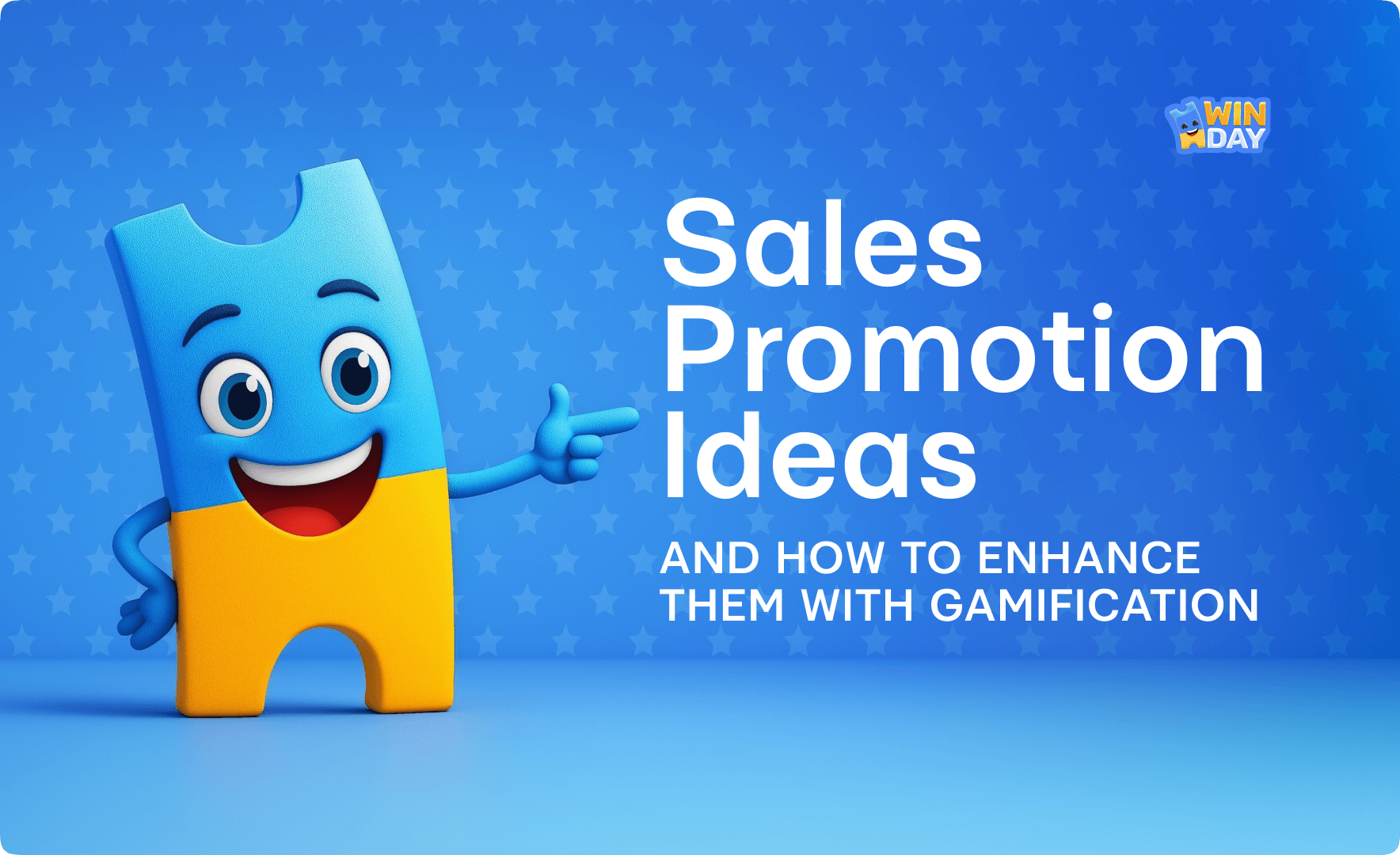How to Improve Customer Retention: Traditional Strategies and Gamification Approach
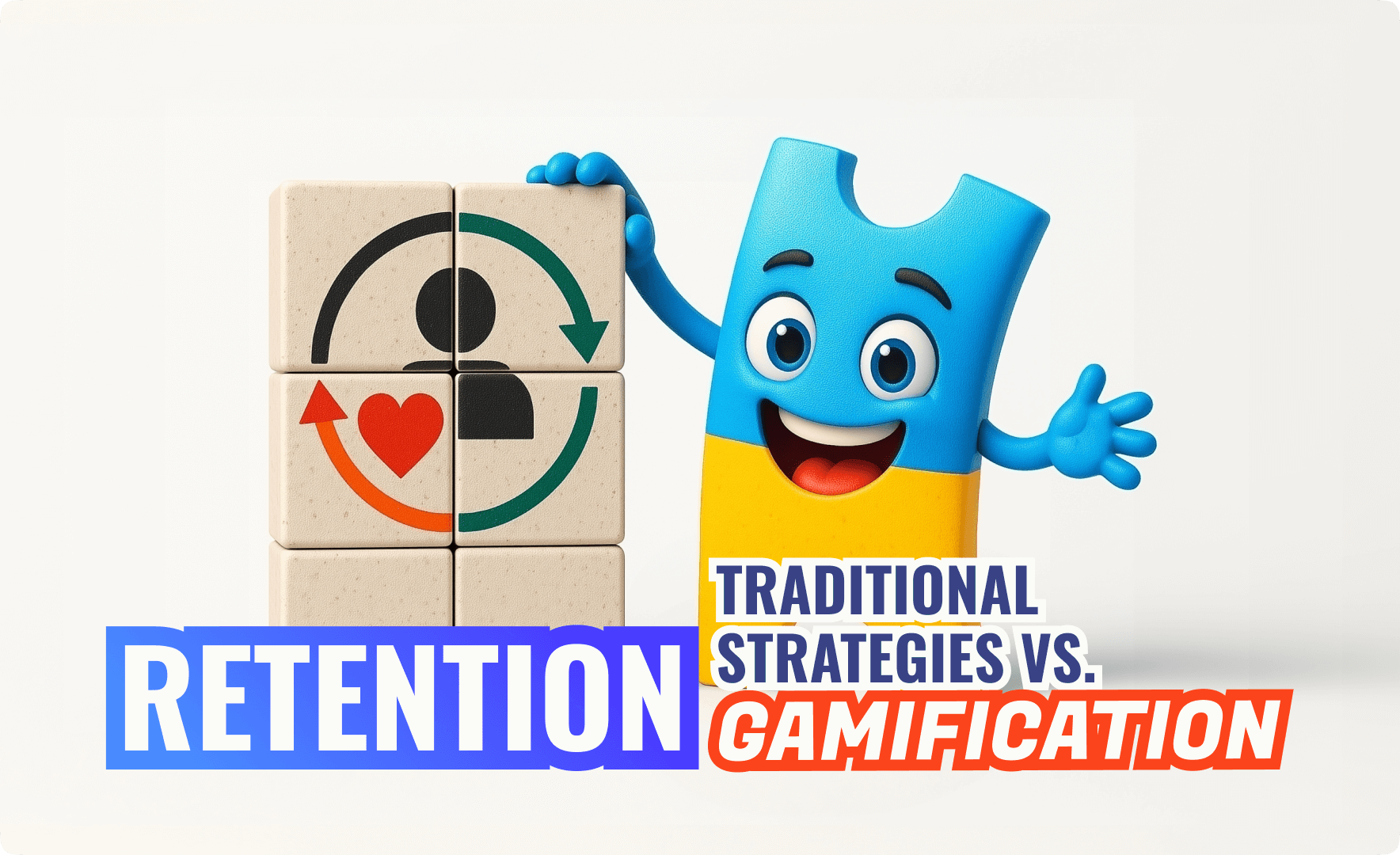
When it comes to key drivers of business success, people often mention a brand’s ability to attract new customers. However, a truly critical step is the next one – turning the customer into a repeat buyer. The competition for every single customer is strong these days, and to keep them on your side in the future, you must offer an interesting, if not creative, experience.
All the traditional, tried-and-true customer retention strategies remain important, but they lack the benefits that gamification offers. If you are not yet familiar with gamification as a customer retention tool, let’s do a quick summary.
The adoption of gaming techniques outside a gaming context has proved to be a highly efficient tool for boosting customer loyalty in many industries. Points, badges, rewards, and everything else we used to see in gaming are now powerful psychological elements that actually make people stay longer with a specific brand or company.
In this article, we will explore foundational customer retention strategies, plus how gamification, especially via Winday marketing games, increases customer lifetime value and reduces churn. Keep reading!
What is Customer Retention, and Why is it Important for Businesses?
Let’s start with a definition. Customer Retention refers to the the percentage of customers who continue to purchase from a company or remain active over a specified period. The Customer Retention Rate (CRR) is a metric that quantifies this. It is calculated as the number of customers at the end of a period (for example, a year). The main benefits of higher retention are lower spending on acquiring new customers. Plus, it guarantees you more stable revenue streams.
The financial and strategic importance of customer retention is hard to overstate. On the surface, it may seem like a great tool for keeping people engaged, and it is. More importantly, this is a cost-effective way to grow a business.

Customer Retention Rates by Industry shows average customer retention rates across various industries. Media and Professional Services lead with 84%.
So why is customer retention so important for businesses? The cost of marketing and sales is skyrocketing every year, making customer acquisition strategies less and less viable. The cost of acquiring a new customer most likely outweighs the revenue they bring, unless they remain with the business for a long time.
In light of this reality, nurturing and applying retention strategies leads to substantial benefits for businesses. Not only will your loyal customers continuously buy from you, but they will also try your new products and support new initiatives. In the long run, this is a solid foundation for scalable business growth.
How to Measure Key Customer Retention Metrics
To really understand your customer retention performance, you need to gaze into several metrics and read them carefully. Here are the most important ones:
Customer Retention Rate (CRR)
Customer Retention Rate (CRR) shows the percentage of customers you’ve acquired who remained with you over a specific period. It is the most basic and essential of all customer retention metrics.
Customer retention rate formula: CRR = (E-N)/S x 100%
Where E – number of customers you had at the end of the period. N – the number of new customers you got during that time. S – the number of customers you had at the start of the period.
Start with the number of customers you had at the end of the period (let’s call this E). If you’re measuring for the whole year, count how many customers you had on December 31. Subtract the number of new customers you got during that time (N). This helps you focus only on the customers who stayed with you, and not mix them with those who just joined. Divide that number by how many customers you had at the start of the period (S). Multiply by 100 to get a percentage. That’s your current Customer Retention Rate.
Customer Churn Rate
Customer Churn Rate measures the percentage of customers you’ve lost over a given time period. If your churn rate is high, then it is a clear signal that something is off and needs your attention. It can be anything from product issues to customer experience problems. Make sure to identify the cause of the problem and fix it.
Customer Churn Rate formula = Customers lost during period ÷ Customers at start of period × 100%
Here’s how it works. Let’s say you started with 100 customers and lost 15 during the quarter.
Churn Rate with these numbers would be = (15 ÷ 100) × 100 = 15%
Repeat Purchase Rate (RPR)
Repeat Purchase Rate (RPR) indicates what percentage of your customers made more than one purchase. Naturally, the more repeat purchases they make, the better your customer retention strategy works.
Repeat Purchase Rate Formula: RPR = Number of Customers with more than one purchase ÷ Total Number of Customers × 100%
Lifetime Value (LTV)
Customer Lifetime Value (LTV) measures the value a customer brings over their entire interaction with your business. The longer a customer stays with you, the higher their lifetime value. This is a core metric that helps clarify the customer retention meaning, as it directly ties long-term loyalty to revenue potential and helps you calculate the total possible revenue from your users.
Livetime Value formula: LTV = Average Purchase Value × Purchase Frequency × Customer Lifespan
Basically, you need to multiply the average amount a customer spends in a transaction by how often they purchase within a given time. Then, multiply the result by the typical length of time a customer continues buying from your business.
Traditional Strategies to Retain Customers
Gamification is a relatively new and powerful customer retention marketing tool. However, its effectiveness doesn’t mean foundational customer retention strategies are no longer important. They are, and applying them with gamified elements can be a winning solution.
Customer retention strategies appeared mostly from listening directly to a customer and acting on the feedback. That’s why the best practices for customer retention include direct or indirect communication with the audience.
Plus, customer expectations around value, service, and relevance drive these strategies. If you execute them well, expect a boost in loyalty needed for long-term retention.
Let’s take a look at the main traditional customer retention strategies.
Frequent Feedback Collection and Quick Response
Listening to your customers and responding with care goes a long way. It’s not a new idea but an essential one that has proven itself across all industries. Two-way communication allows brands to see what is working and what’s failing to deliver, and even more importantly, it shows customers that their input has value.
There are a few common ways to collect this feedback:
- Post-purchase surveys: short questionnaires you send after they’ve completed a purchase. The goal is to understand how their buying experience went, and with surveys, you can get answers quickly. It helps to identify any friction in the customer journey right after it happens.
- Net promoter tracking: This is a simple way to measure customer loyalty. Usually, it is just one question: “How likely are you to recommend us to a friend or colleague?” Customers answer on a scale from 0 to 10. Besides, according to the classic Harvard Business Review piece on customer loyalty, this metric is also highly useful for investors.
- Email follow-ups: Personalized emails are sent after a purchase is made. They might ask for feedback, offer help, or simply check in to see how things are going. Email follow-ups are useful for building a relationship with the customer and encouraging repeat business.
- In-app surveys: Since many products are digital these days, you don’t have to leave them in order to get a customer’s opinion. You can place short surveys directly inside the product. These are often triggered by a specific action or time spent using a feature. If you are looking for quick, in-context feedback without interrupting the user too much, this is the best option.
- Review monitoring: Check what people are saying about you on review platforms to spot patterns (good or bad) and respond when necessary.
These strategies are relatively easy to implement and provide ongoing insight into the customer experience. Plus, acting on it quickly can increase customer retention.
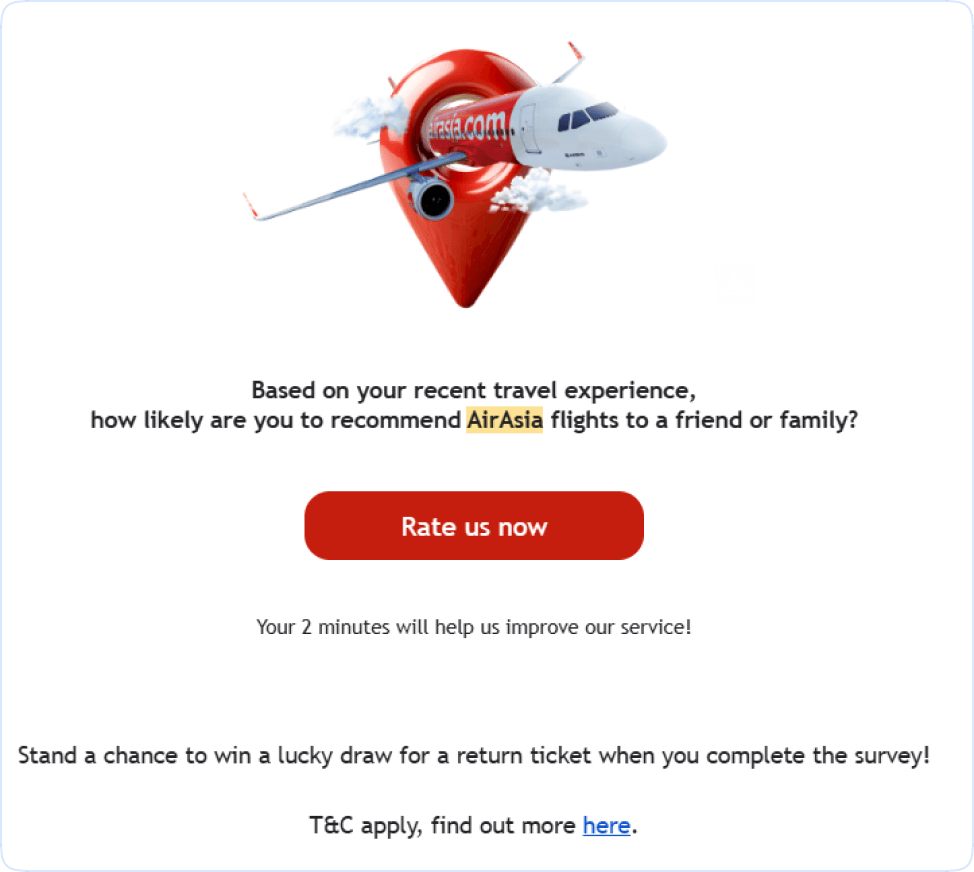
An example of an email follow-up from AirAsia that asks customers to rate their recent travel experience for a chance to win a return ticket.
What matters just as much as gathering feedback is how quickly you act on it. If you react promptly by fixing a known issue or simply taking a gesture as formal as thanking a customer, you are building both customer satisfaction and retention.
The insights you gather over time can (and should) lead to actual improvements. Maybe it’s a product update, a change to your support process, or a tiny adjustment in how you engage users through loyalty features or gamified tools. All feedback is a chance to make a difference.
Effective Loyalty Programs, Discounts, and Reward Systems
Loyalty programs are systems that give customers something back when they keep buying from you. That “something” could be points, discounts, free items, or special perks. The goal is to reward repeat behavior and provide customers with extra value for continuously supporting your business.
Loyalty programs work well because they give a feeling of being appreciated, which is a good way to encourage repeat behavior. The psychology behind it is quite simple yet efficient: if you are feeling valued, you are more likely to return.
There are a few common formats:
- Tier-based programs – customers move up levels and unlock better rewards the more they spend.
- Point-based systems – every purchase earns points that can be traded in for discounts or products.
- Surprise rewards – these can include birthday discounts or thank-you gifts, adding a more personal touch.
- Paid loyalty programs – customers pay a recurring fee to access something exclusive.
The best loyalty programs are easy to understand, and they are relevant to the customer. A perceived value most often determines a program’s success or its failure. For example, Booking offers a very easy-to-understand Genius program. When you book flights, accommodations, or cars, you move up and get discounts, free breakfasts, or better deals. Programs like this demonstrate how to retain customers by rewarding ongoing engagement with meaningful benefits that people enjoy.

An example of an email follow-up from An overview of the Booking.com loyalty program and its benefits across different levels.
All the rewards that we just mentioned can be more interactive and gamified. When done right, they create a more creative and emotionally engaging experience that transforms the way customers interact with your brand.
Personalized Services and Support
Personalization used to be just a trend, but slowly it has turned into an absolute necessity. In fact, according to the Segment’s State of Personalization report, 89% of leaders believe personalization is crucial to their business’s success in the next three years. Faceless marketing is a thing of the past, as people now expect more nuanced services; they want to feel they are seen, and brands shouldn’t treat them like mere numbers.
At this point, it is worth asking yourself a question: What is customer retention without personalization? Is it even possible?
Personalized experiences strongly encourage emotional loyalty. Customers will return to you not simply out of habit or convenience, but because they felt an emotional connection. There are countless examples of personalization approaches you can apply:
- Include the customer’s name in emails or messages, rather than using impersonal greetings.
- Recommend products or content based on past behavior.
- Offering dedicated support, for example, from a manager.
- Give customers options, like choosing how they’re contacted or what content they see.
Many businesses find it hard to gather data to make the customer experience truly personalized. However, with the recent expansion of AI tools, it is actually easier than ever. AI-driven personalization is becoming more accessible to even mid-sized companies, so it’s no longer a privilege reserved only for big brands.
In the end, customers tend to stay with brands that seem to “get” them. Brands that remember their preferences, anticipate their needs, and make things a little easier or more relevant each time they interact. It’s no wonder: people perceive brands as human, with real personalities (strange as it sounds, it’s true). Naturally, they judge brands the same way they judge real people.
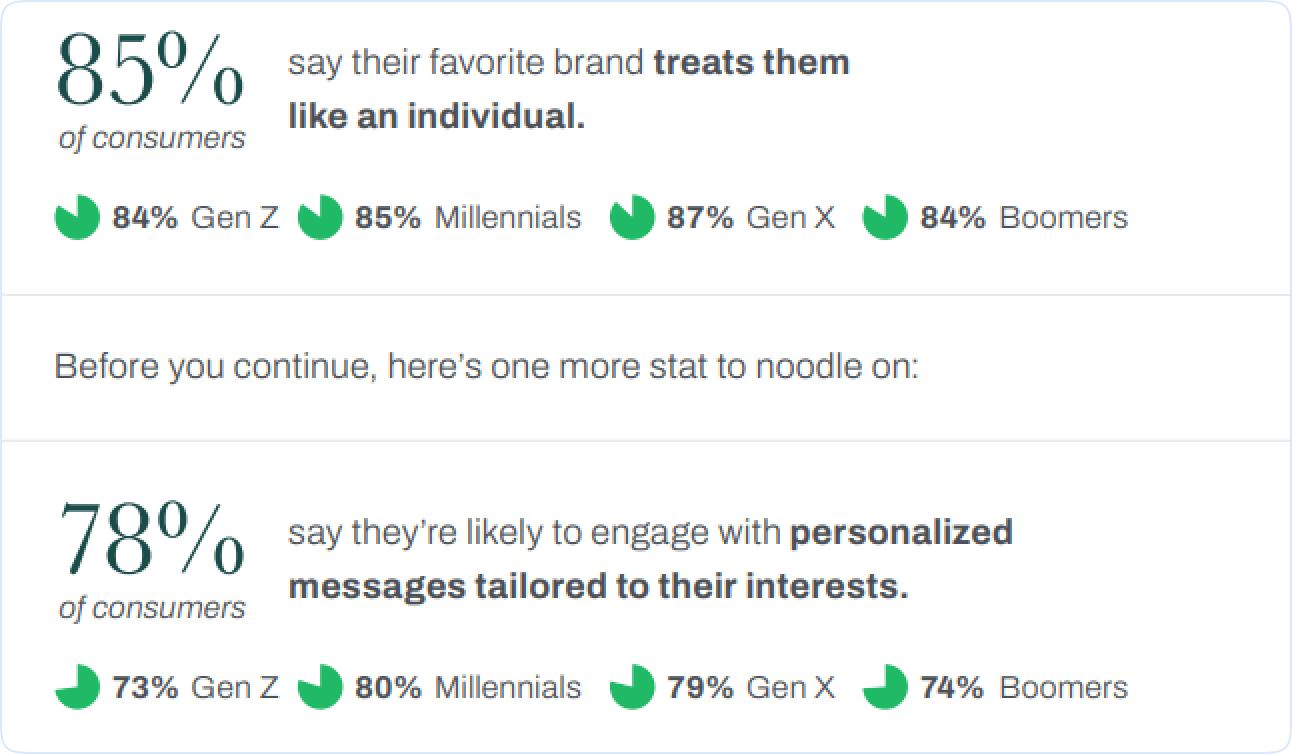
Statistics about how consumers feel about personalization in branding and marketing.
We are past providing just an excellent service; people want to feel that every interaction was built with them in mind. Cultivating emotional bonds with your customers by providing personalized experiences is a great way to build your customer retention strategy.
💡 Did You Know?
In 1995, the UK supermarket Tesco launched its Clubcard loyalty program. It was one of the first big examples of personalized marketing. The program tracked what each customer bought and sent them coupons based on their shopping habits.
Social Media Activity and Connection
Social media is often seen as a promotional tool or a platform to advertise your brand. And yet, while you can use it this way, it is better to consider it as a relationship-building tool. These are the places for establishing an ongoing connection.
Why? Well, Facebook, Instagram, and TikTok play a big role in shaping how people feel about your brand. In fact, your online brand personality consists almost completely of how you present it on social media. Naturally, these and other platforms are perfect for creating familiarity and brand recognition. But how can you be more than just a part of their scroll?
First, post consistently. Of course, it doesn’t mean posting just for the sake of it, without really caring about quality. If you show up just once in a while, don’t follow a clear content strategy, your relationships with the audience will be rather erratic.
The same goes for a personal connection. It is vital to respond to comments and DMs, which, if you think about it, is also a part of making the interactions more personalized.
🔝 Pro Tip:
React to feedback within 24 hours and tie insights into product or game features.
Featuring user-generated content is another way to strengthen relationships with your customers and improve customer retention. It also emphasizes the importance of customer retention, as it turns loyal customers into brand advocates.
This is a good marketing tactic – you can have your audience act like an extension of your marketing team, and show others that your brand is open to featuring user-generated content on social media.

Why User-Generated Content is important when customers purchasing.
Community-focused content like polls, stories, and hashtags can go even further. These tools invite participation and let people feel like they’re part of your brand activities. In turn, it triggers more shares, reposts, and other social media activity around your brand.
Upsell to Existing Customers
Upselling is often overlooked, but a very powerful way to increase customer value and one of the easiest answers to how to improve customer retention. It means encouraging customers to choose a slightly more expensive but improved version of what they’re already buying. Of course, it should have an upgrade or enhancement that improves their overall experience.
It might be easy to confuse upselling with a similar-sounding term – cross-selling. Businesses use them to increase average order value, but at their core, they are different. Upselling focuses on upgrading the original product or service, which could mean a premium plan with more features instead of a basic one. Cross-selling, on the other hand, suggests additional but related products, like “buy a bag for your new laptop”.
Upselling can be merely a useful recommendation. For example:
Personalized product bundles. Based on what the customer is viewing or has bought before, you can suggest bundles that combine the core product with useful extras. However, they should come at a better value than buying them separately.
Discounted upgrades at checkout. Just before a customer completes a purchase, you can offer a limited-time deal to upgrade. For example, with premium features for 20% off. This works well when the added benefits are clearly stated and feel like a natural extension of the original choice.
Post-purchase upsell emails. Sometimes customers need to try a product before deciding to upgrade. If you add follow-up messages with a clear added value, you might pique their interest.
If you upsell the right way, you can enhance the value of your offering without resorting to pushy, often repulsive sales tactics. Upselling nurtures loyalty when it helps customers get more value from their original purchase. You can ensure customer satisfaction and retention through this approach.
To implement upselling more effectively, it’s also useful to understand the types of business models in e-commerce, since strategies can vary widely between B2B, B2C, or marketplace setups.
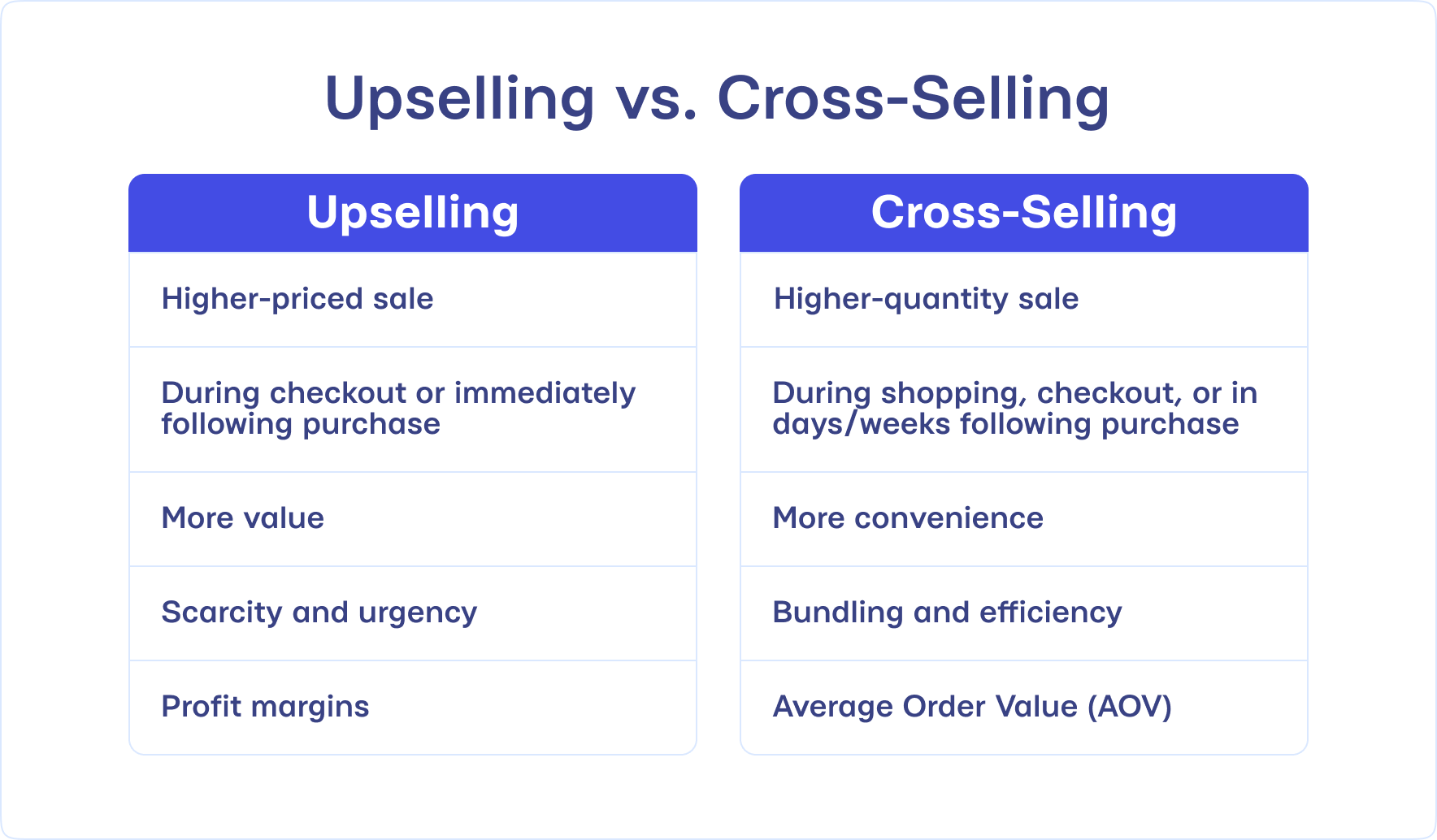
The difference between upselling and cross-selling, two common sales techniques used to increase revenue.
How Gamification Improves Customer Retention
If you think about it, all the traditional customer retention techniques are more about marketing. They work, but they speak more to logic than behavior. Gamification is more of a psychological and behavioral tool, and its impact is fundamentally different.
At the core of gamification mechanics are systems designed to create a feeling of progress and reward. These aren’t new ideas, because games have used them for years. But applied to business, they can quietly build habits that bring customers back time and again.
All the things that are familiar to us from games like progress bars, levels, or tiered experiences help to encourage return behavior. Why? Because human psychology is wired to seek completion. When people are 80% of the way to the next level, they’re more likely to return to finish. This kind of approach is a smart example of how to retain customers by motivation, not pressure. This is how you can increase customer retention without needing any kind of hard sell or push.

Study shows that gamification can boost user engagement by 100–150% compared to traditional recognition methods.
Engagement Through Interactive Experiences
Points, badges, and leaderboards are probably familiar to most people through fond memories of childhood gaming. And if you think adults don’t need or enjoy gamified experiences, you’re wrong. On the contrary, they are essential, and finding them when interacting with brands can’t go unnoticed.
Simple progress bars and levels are great for motivating customers to return. All humans love the feeling of progress, even if it’s something small. So, awarding levels for purchases or giving badges based on a customer’s history is an excellent idea.
You can create something like a hierarchy path for your customers. The more active they are in engaging with different features you offer, the more they move or receive some special offers. It is literally like in actual games: there are various difficulty levels, and the more time you spend there, the more you’ll achieve. It is hard to deny how the same approach can be one of the best customer retention strategies.
Many sports apps have introduced leaderboards and personal achievement systems. They display badges for completing specific challenges. For example, Nike Running Club (which is full of gamified elements) provides a full board of achievements and running levels. A very similar system is also available on Strava.

Achievements board with a collection of badges in the Nike Running Club app.
With such an approach, you’re changing the customer retention definition. It becomes less about marketing and more about providing a valuable, engaging experience in itself.
Motivation and Habit Formation
It may not seem immediately obvious, but gamification also helps build routines. Daily check-ins, reward streaks, and time-based challenges give users a reason to come back if not every day, then at least regularly. Over time, this kind of structure builds familiarity and habit, which are two things you need for long-term retention.
For sure, you have encountered it as a customer already. For example, many coffee shops offer a special streak card. The idea is simple: come back and get your card stamped. Once you have enough stamps, enjoy your free coffee.
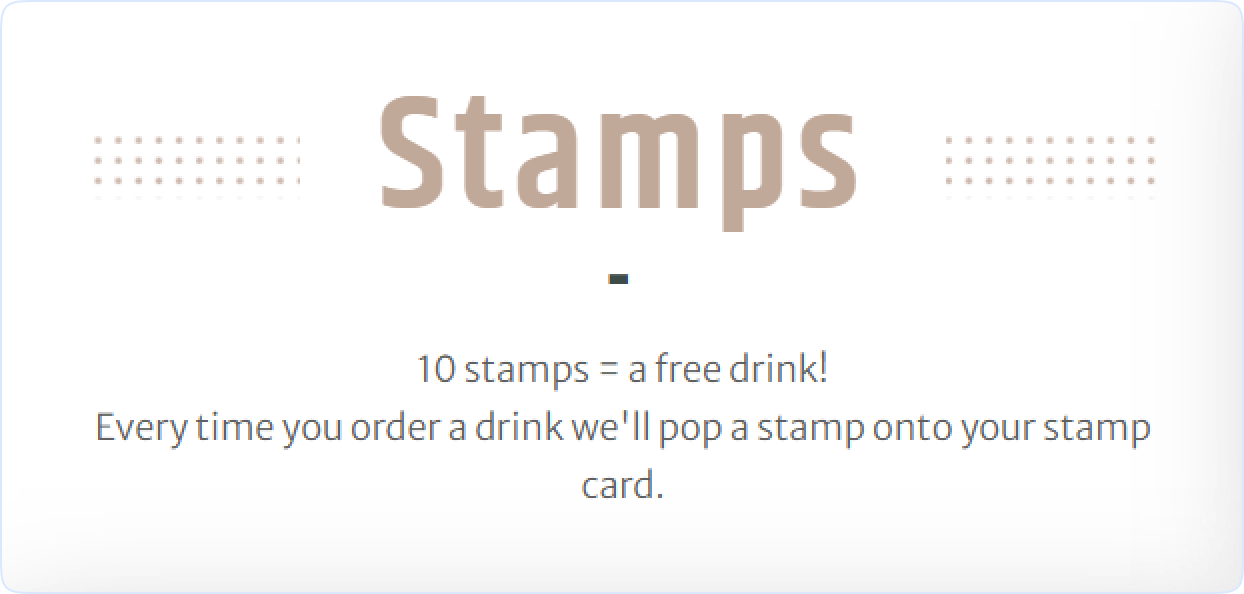
A classic stamp-based loyalty program: Collect 10 stamps and earn a free drink.
Traditional rewards (for example, discounts) appeal to value, while gamification appeals to momentum and satisfaction. Even if the customers are not actively shopping, they have other reasons to come back.
💡 Did You Know?
Gamified loyalty programs raise customer engagement by up to 47%.
Winday’s Branded Tournaments for Retaining Customers
How can you implement not just gamified elements, but actual gaming experiences? To answer it shortly, you can do it with Winday.
Winday gamification platform provides tools for creating, publishing, and distributing playable marketing campaigns and interactive experiences. You can create interactive branded games in minutes without coding. It works for businesses of all sizes and various industries. But how can it affect your customer retention marketing?
Winday’s Branded Tournaments offer a practical way for businesses to encourage customer retention through gamified experiences. For example, merchants using Winday can host branded, time-limited tournaments. Here’s how the flow works:
- A customer makes a purchase online or in a physical store.
- They receive time-limited code, which can be printed on the receipt or sent to a customer’s email.
- Then, the customer uses that code to enter a branded tournament hosted by Winday.
- They play games, collect points, and earn achievements.
- When the code expires, they are encouraged to make another purchase and receive a new code.
These tournaments might offer points or prizes, and their time-limited nature helps create a sense of urgency. In the long run, implementing such gamified experiences is a great way to increase customer retention.

To put it simply, Winday tournaments are structured to encourage customer return and brand engagement. Here are the main things you should know about:
- Games reward participation and progress with points, badges, or prizes.
- Additional codes from future transactions can unlock bonus points, giving customers a clear incentive to return and continue engaging.
- Limited-time tournaments drive faster engagement and allow merchants to time campaigns with sales or product launches.
Setting Up a Winday Tournament
Setting up a tournament via Winday is actually very easy. You can choose game mechanics (3 types of puzzles, bubble shooter, and 3D shooter), set the game difficulty level, duration time, and choose a graphic theme or order a custom one. You’ll also create tournament rewards. First, second, and third prize tiers should be unique, while the rest can share a common prize.
There are also many ways to publish these tournaments. You can use links, QR codes, website embeds, emails, or even physical promotional materials. This flexibility makes them a versatile tool for retaining customers across multiple touchpoints.
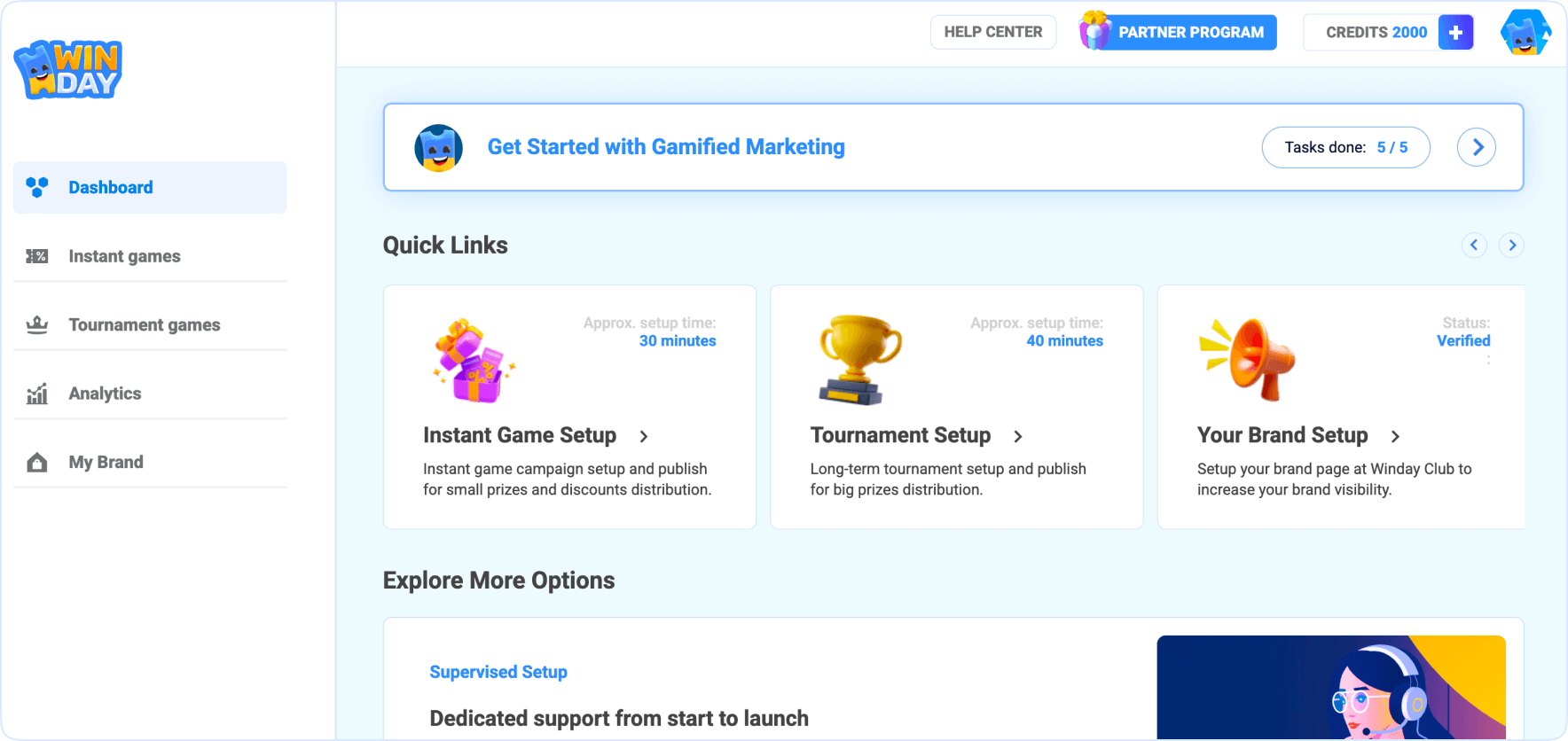
Dashboard of Winday gamification marketing platform
Would you like to test these tournaments? Get started with Winday for free right now!
Deep Integration with API
If you are looking for a more automated and integrated approach, Winday provides API access. This is a great way to make the experience for both the business and the customer smoother and ultimately easier, while also supporting your strategy for retaining customers.
What extra possibilities do you have if you choose an API?
- Automatically distribute codes at checkout, both online and in-store
- Create personalized game experiences based on purchase history or customer data
- Maintain consistency on all your platforms and minimize manual setup

Possibilities of integrating Winday games and tournaments with your platforms.
This integration is ideal for larger businesses or e-commerce platforms that need easy-to-perform workflows and scalable retention strategies.
Are you interested in API integration? Contact the Winday team for setup guidance and support! We are just one step away from you.
Customer Retention Challenges for Offline and Online Merchants
Of course, retaining customers as an offline merchant isn’t the same as doing it online.
One of the main challenges for offline businesses is the lack of direct digital re-engagement tools. They do not automatically collect customer data during a transaction like online businesses do. So, how can you implement the strategies we mentioned above-follow-ups, encouraging repeat visits, or delivering BOGO promotions during the initial purchase?
If you want to overcome this, proactively create opportunities to collect customer contact information. Common methods include:
- Asking for email or phone numbers at checkout
- Placing QR codes on receipts or signage that link to a short signup or game entry form
- Offering participation in gamified campaigns (e.g., branded tournaments or prize draws) as an incentive to provide contact details
Online merchants, naturally, have an enormous advantage when it comes to data collection. At checkout, customer information is gathered automatically. This opens up space for more sophisticated customer retention marketing strategies:
- Automated email sequences after purchase
- Personalized loyalty rewards and offers
- Targeted retargeting through ads or social media
However, we can’t possibly assume that the digital space doesn’t have its own set of challenges. We all live in the era of information overload, and customers today face constant notifications and digital fatigue, making it harder to stand out and maintain long-term engagement.
To address this, online businesses need to invest in well-structured customer journeys that deliver value without overwhelming users. As we mentioned already, gamified experiences are also much needed to break the routine and recapture interest. Timing and relevance remain vital. You have to make sure messages are personalized and action-oriented. Leveraging the right martech tools for startups can make this process more efficient, helping small businesses deploy automation, personalization, and performance tracking from the start.
Bridging the Gap with Gamification
Yet, for offline and online merchants, gamification can serve as a powerful common solution to boost customer retention. Interactive experiences help to increase engagement across both environments and affect repeat purchases without changing a product. Plus, gamification makes re-engagement feel like a benefit rather than an interruption.
Final Takeaways
Customer retention is a key driver of growth, and it is hard to find proof for the opposite. Improving retention leads to higher lifetime value, lower churn, and helps businesses scale without spending large portions of their budget. If you mix traditional retention methods with gamification, strengthening emotional connection with your audience and building lasting loyalty will be much easier. Isn’t that what all brands need?
Gamified experiences like Winday tournaments can turn casual shoppers looking for a one-time purchase into loyal customers.
Are you ready to start a free Winday tournament? Book a demo with our team or contact Winday for full implementation or consultation, and make your customer experience genuinely exciting!
Rate this article
Keep Learning
What is Brand Engagement and how to increase it with Gamification
What is brand engagement, and what is the role of gamification in it? In a this article, we explore brand engagement and how gamified elements can improve it in your business.
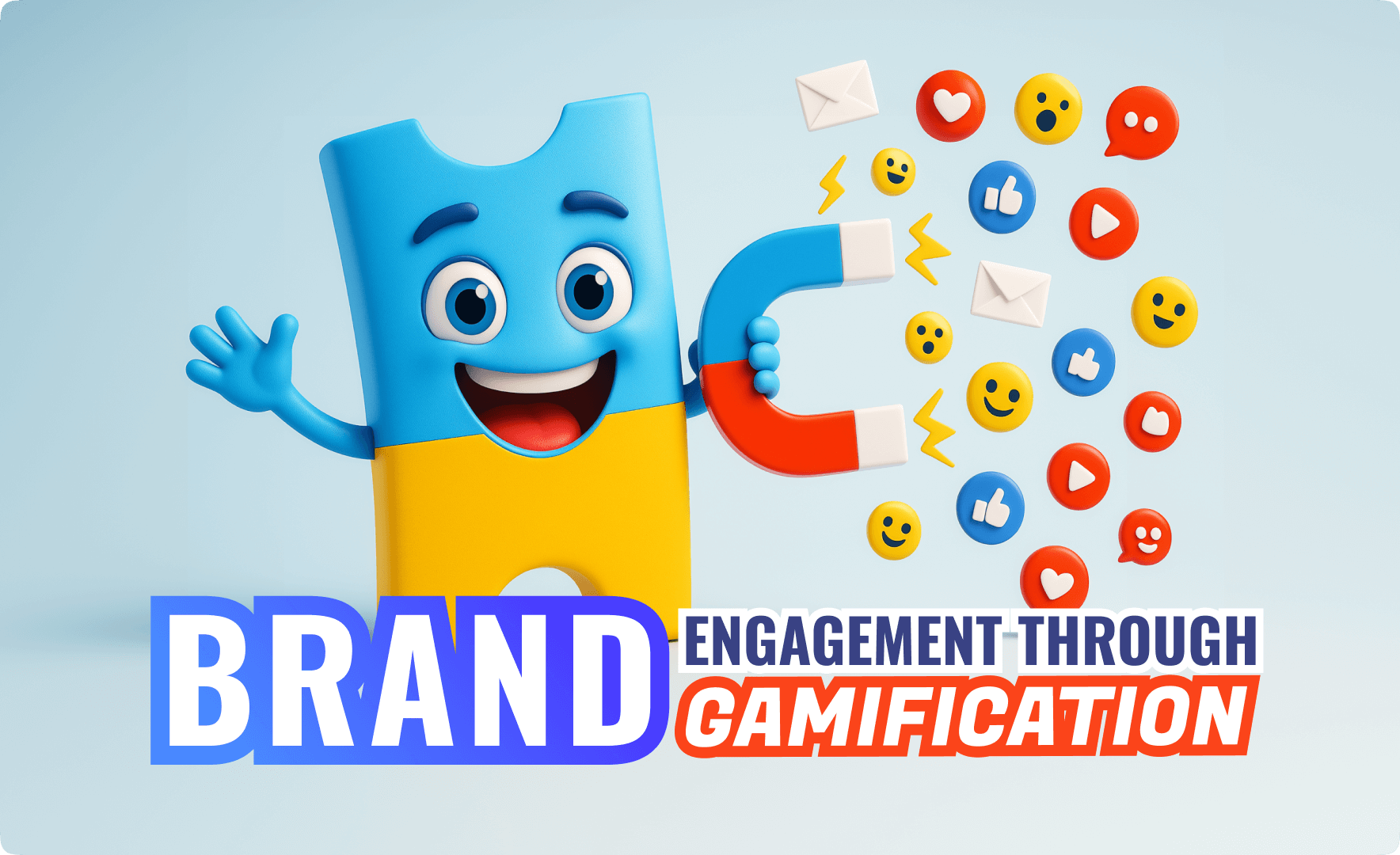
13 Main Types of eCommerce Business Models
Interested in starting your eCommerce business? This guide will help you understand the different types of eCommerce business models.
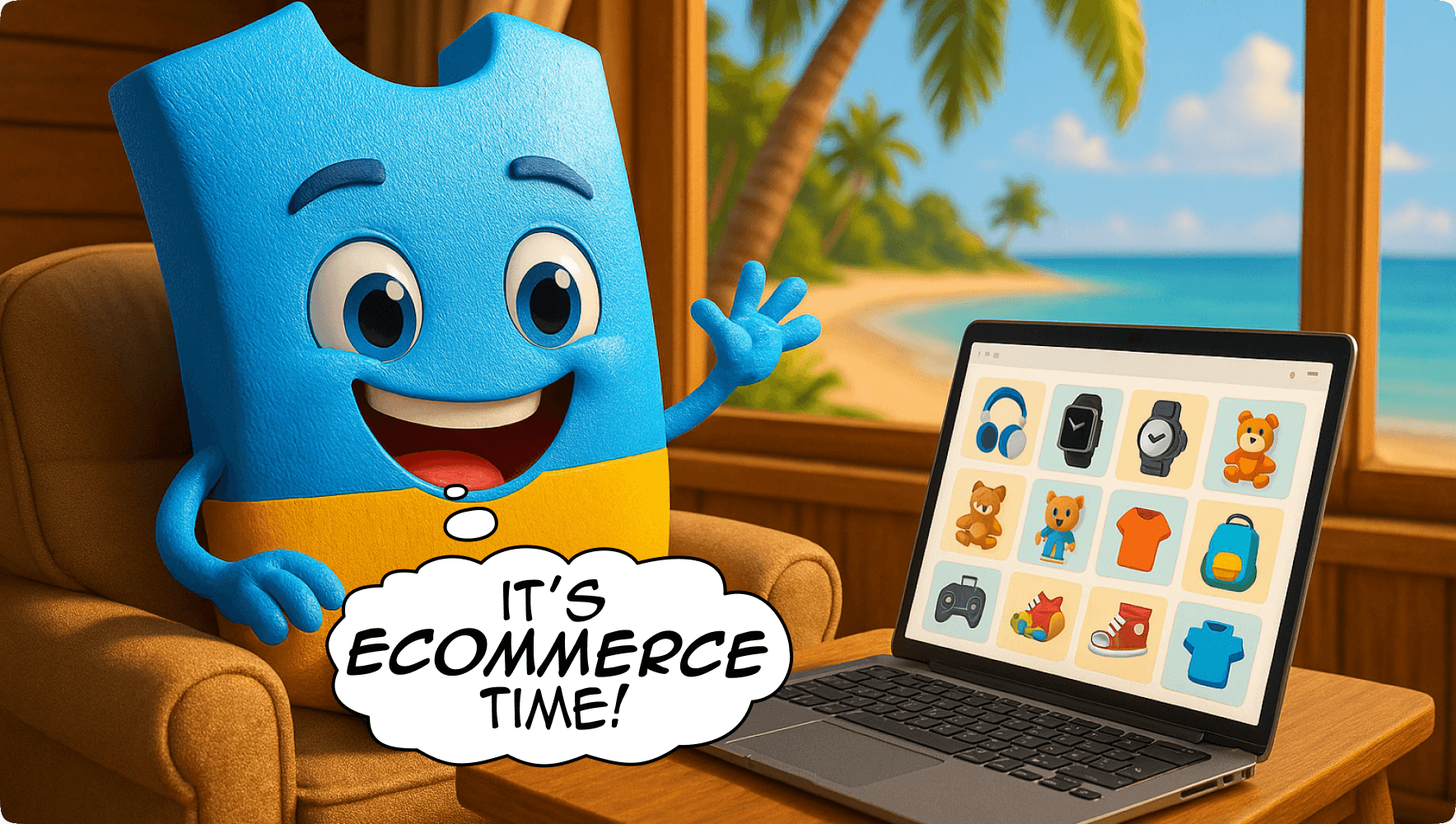
Sales Promotion Ideas and How to Enhance Them with Gamification
Selling today is part art, part smart tactics. Check out classic promotional ideas that still work and are used widely, and see how adding gamification can turn them into real crowd-pullers.
